14.5” barrels with permanently attached muzzle devices are very popular among AR-15 builders for good reason. This configuration saves weight and provides the shortest possible barrel length without having to apply for a tax stamp. However, for all the upsides, there are also downsides that it seems some shooters don’t think about until it is too late.
The moment that muzzle device is pinned and welded to your barrel, your options become extremely limited. You obviously can’t remove your muzzle device easily, you can’t fully remove your gas block, you can’t fully remove your barrel nut, and all of that means your hand guard options are limited.
The good news is that, with a little forethought and planning, you can maximize your available options should you ever want to change the configuration of the carbine later.
Choose Your Muzzle Device Wisely
Choosing a muzzle device is easy when you know you can just take it off and replace it. It becomes a lot more challenging when you are going to be attaching it permanently. You will have to live with the device that you choose for a long time or go through a headache to replace it. I tend to choose closed end flash suppressors for perm attachment for several reasons.
First, the muzzle devices that I have seen damaged most commonly are long, pronged flash suppressors. I have seen prongs bent or even seen them bloom open like a flower as round counts increased. That is rare, but it can happen.
Second, flash suppressors are more stable in terms of development. If you attach the hot new muzzle brake, it won’t be the hot new muzzle brake for long. Flash suppressors tend to have a longer shelf life and seem to less subject to the whims of a fickle muzzle device market. Choose a device with a long track record of working well for your specific application.
All of the above basically adds up to an extended A2 flash suppressor for me. It is reasonably effective as a flash suppressor, never goes “out of style,” inexpensive if you have to destroy it when it is removed, and it has a closed end design that you are unlikely to damage or wear out. It also happens to be the most cost effective choice.
You could also choose a device like the Adams Arms Manimal which is an extended A2 style flash suppressor with a small enough outside diameter to allow the gas block, hand guard cap, and barrel nut to slip over it. That would basically mitigate everything I am saying in this article but the Manimal is not as thick as most devices and its long term reliability is unproven at this point.
I am not dogmatic about choosing a flash suppressor for this application. Choose whatever device works best for you after a realistic assessment of your skill, intended application, and budget.
Gas Block Considerations
The standard front sight base is probably your more versatile gas block option for a 14.5” barrel. It can be used in conjunction with the hand guard cap to allow the use of various inexpensive non-free float hand guards like standard hand guards, Magpul’s MOE hand guards, or various drop-in railed hand guards.
The standard FSB can also be ground down to work as a low profile gas block while still in place on the barrel. This allows the use of various extended free float rails (more on this later).
If you know you are going to be using an extended free float rail, you can start with a low profile gas block.
Gas System Considerations
There are a number of 14.5” barrels out there with mid-length gas systems and while they tend to be very soft recoiling, I generally prefer a carbine length gas system on a 14.5” barrel. Carbine length gas will offer the most hand guard options, be a little less picky about ammo, and get in the way a little less when it comes to mounting accessories on extended hand guards.
I should probably explain a few of those a little further. I say carbine length gas systems have the most hand guard options because of the various front sight cutout rails that are available. There are very few of these available for the mid-length gas system and some of those that are available are too long to be used on a 14.5” barrel.
The comment regarding getting the way less refers mostly to the slim, slick sided free float tubes that allow you to direct connect accessories. Those systems tend to use screws with some kind of nut or plate to attach which can be long enough to contact the gas block in some situations. If you are using an extended hand guard, you are likely to be attaching most of your accessories right around the part of the barrel where the mid-length gas black sits which is the widest part of the barrel and thus the most likely place for there to be undesirable contact. This is less of a concern if your gas block is very low profile, your rail has a larger diameter, or you are using a railed hand guard.
There really isn’t a wrong answer here but if you want the configuration that gives you the most options down the road, a carbine length gas system is probably the way to go.
Stick to Hand Guards that Use the Standard Barrel Nut
The number one thing to avoid when you are building a 14.5” carbine is free float rails with non-standard barrel nuts. Once the muzzle device is attached permanently, that barrel nut isn’t coming off which means you are likely going to be stuck with that hand guard for a long, long time. If the rail that you are using is discontinued by the manufacturer, you may find yourself up the creek with a paddle.
Thankfully, there are several rails on the market that attach to the standard barrel nut. There always has been and there likely always will be.
Two piece designs like the Centurion Arms C4 rails are especially well suited to use on barrels with permanently attached muzzle devices since they can be attached while the FSB is still in place.
If you have a low profile gas block, you have even more options. The Samson Evolution Rails (and derivatives), Fortis REV, Apex GatorGrip and others attach to the standard barrel nut and can be slipped over a low profile gas block to install.
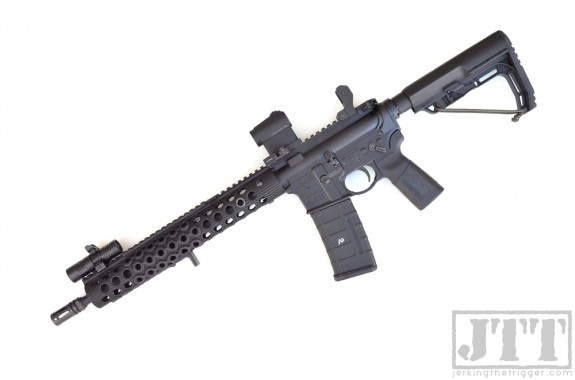
I no longer recommend Troy products as a result of various hiring decisions they have made but their hand guards do work very well in this role.
Adding it Up
If you add up everything above, the most versatile barrel configuration to use on a 14.5”, non-NFA build is probably one with a standard FSB, carbine length gas system, and a standard barrel nut. This configuration will render the maximum amount of choices right away and in the future. The muzzle device choice is a bit more personal and something you will have to sort out on your own.
Don’t get trapped with a 14.5” carbine that can’t adapt as your shooting style changes and the state of the art advances. If you follow the advice above, you will always have options.

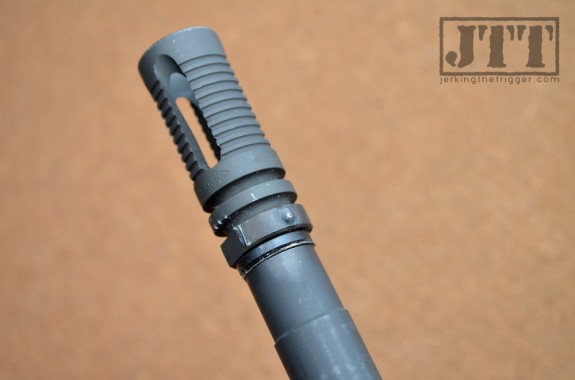
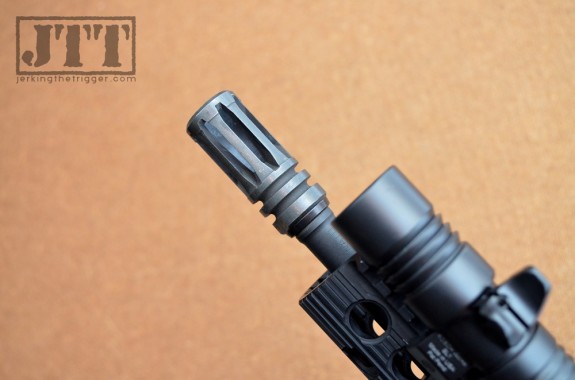
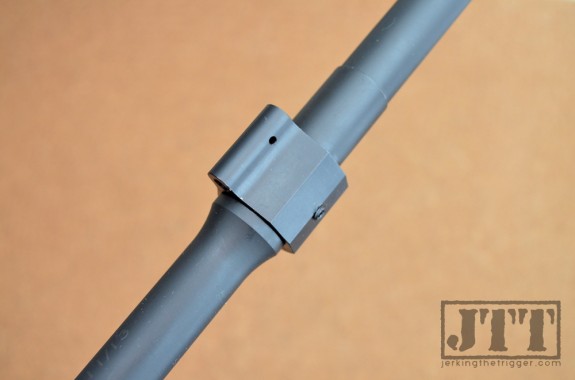
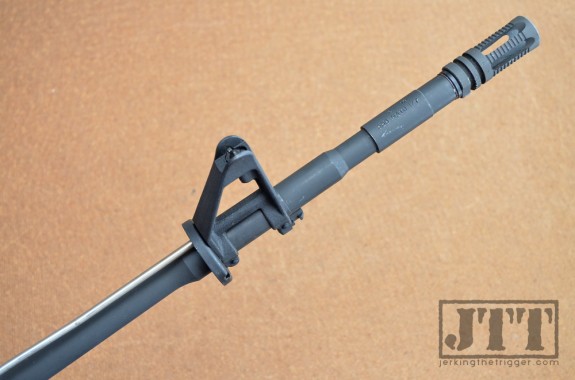
Great article, obviously written from experience Matt. I read your guy’s site daily and really appreciate the content. I wanted to add a few things that may have been glossed over:
1) Muzzle devices are numerous and actual comparisons are few and far between. A great resource is a series of articles from Vuurwapen Blog (http://vuurwapenblog.com/2014/01/12/ar-15-muzzle-device-comparison/). What you will read there will no doubt surprise most readers. You are spot on with the A2 recommendation for most shooters.
2) Gas port location – carbine vs. mid-length: The reason mid-length gas systems –on a 14.5″ barrel– can be more picky with ammo is due to the time the bullet remains in the barrel once it passes the gas port. That dwell time past the gas port is important because as the dwell time is shortened the gun needs more pressure in order to cycle. A carbine gas port should be 7.8″ from the chamber or have 6.7″ of barrel past the gas port. A mid-length gas port should be 9.8″ from the chamber or have 4.7″ of barrel pas the gas port. This means that a carbine length gas ported barrel has 2 more inches or about 30% more time to build pressure before the bullet leaves the barrel and will not require ammo with as high of pressure to cycle/function correctly. This shortened dwell time/higher pressure cycle can also lead to increased wear and tear but that is an article for a whole other time.
3) Mentioning that a mid-length low profile gas block often gets in the way of mounting accessories at the very place most people will mount them is extremely insightful and I’ve seen a lot of people run into this problem as well. It is worth while mentioning that the KeyMod attachment system is quickly becoming the industry standard for numerous reasons that are -very- beneficial to those looking into 14.5″ pinned barrels. While most accessories/rails have a “backing” they screw into and sandwich the hand guard the KeyMod system streamlines the components needed to mount an accessory to a “slick” hand guard and eliminates the need for something inside the hand guard to screw into. This means a much lower profile inside the hand guard with less of a chance that the barrel will come in contact with anything which would defeat the purpose of a “free floated” hand guard. The KeyMod accessories will need KeyMod “slots” to mount to just as MIL-STD-1913 accessories need MIL-STD-1913 rails which means a specialized hand guard. Obviously a picture is worth a thousand words here, Google it and it will all make sense folks.
I hope I didn’t step on your post Matt but I think the above information will be useful to a few of your readers. Feel free to use whats in this post and add it to your article in any way you see fit, I know more people are likely to read the article than some long winded comment at the bottom. Keep up the quality content!
Thanks Hank!